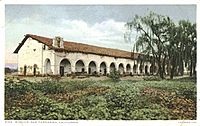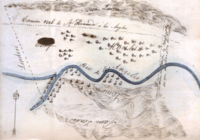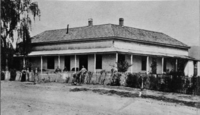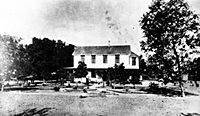History of the San Fernando Valley facts for kids
The history of the San Fernando Valley tells the story of this famous area in California. From its first exploration in 1769 to when much of it became part of Los Angeles in 1915, the Valley saw many changes. Things like cattle and sheep ranching, huge wheat farms, and fruit orchards grew and then faded away.
Throughout its history, how people settled in the San Fernando Valley (often just called "The Valley") depended on two main things: having enough water and being close to important travel routes through the mountains around it.
Contents
Early People and Spanish Explorers
Valley Landscape and First Settlements
Before modern flood control in the 1900s, where people could live in the San Fernando Valley was tricky. They had to avoid winter floods and find water all year. Heavy rains from the San Gabriel Mountains would flood the northeast Valley. This water spread out, sometimes seven miles wide, before going underground. It only came to the surface near the Santa Monica Mountains, creating marshes and feeding the slow stream that became the Los Angeles River.
By 1769, when the Spanish arrived, Native American groups had lived here for at least 7,000 years. They usually settled in places with good water and trees, often at the edges of the Valley.
Native American Tribes in the Valley
The Tongva people lived in the southern Valley near the river. They had villages like Totongna (near Calabasas) and Siutcanga (near Encino), which means "place of the oak." Kawengna (which became Cahuenga) meant "place of the mountain." In the north-central Valley, Pasakngna was a village near springs and a marsh. Other Tongva names still used today include Tujunga ("place of the old woman") and Topanga.
The Tataviam people lived in the valleys to the north. The name Pacoima is from their language and means "the entrance." The Chumash people lived in Malibu, the Santa Monica Mountains, and the Simi Hills to the west. A place called Hu'wam, near Escorpión Peak, was a meeting and trading spot for the Tongva and Chumash. Ancient rock paintings are also found in the Simi Hills at Burro Flats.
Spanish Exploration and Missions
In 1769, the Portolá expedition led by Gaspar de Portolà traveled through California. Two Franciscan priests, Junipero Serra and Juan Crespí, came along. They wrote about the journey and looked for places to build missions, which would connect along the royal highway.
After camping where Los Angeles would later be, the expedition went west. They then turned north through the Sepulveda Pass over the Santa Monica Mountains. Father Crespí wrote about seeing a "very pleasant and spacious valley" with many oak trees. They called it Santa Catalina de Bononia de Los Encinos (Valley of Saint Catherine of Bologna of the Oaks). The expedition camped near a spring at what is now Encino.
Father Crespí thought a spot by the Los Angeles River would be perfect for a mission. But in 1781, the King of Spain ordered a town (a pueblo) to be built there instead. This town became Los Angeles. All the river's water was reserved for Los Angeles, which greatly affected the Valley's future.
Mission San Fernando Rey de España
By the late 1700s, Spain gave out land for grazing north of Los Angeles. Juan Francisco Reyes, a mayor of Los Angeles, had a ranch called Rancho Encino near what is now Mission Hills. His land had plenty of water and good building materials. It was also a day's walk from other missions. Around 1797, he gave this land to the Franciscans for a new mission. In return, he received land in the southern Valley by the spring, which he also called Rancho Encino.
Mission San Fernando Rey de España was founded on Reyes's original ranch site on September 8, 1797. The mission's grazing lands covered the flat Valley floor. The Valley soon became known by the mission's name.
The priests aimed to "civilize" the native people. They called the native people associated with Mission San Fernando "Fernandeños," no matter their original tribe. By 1826, the mission had 541 Native Americans working there. They tended to 56,000 cattle and 1,500 horses. The mission was known for its red wine, pomegranates, figs, and olives.
Mexican Rule and Ranchos
The Rise of Ranchos
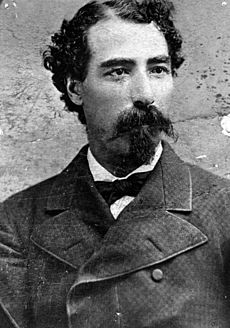
In 1821, Mexico won its independence from Spain, and California came under Mexican rule. New laws made it easier for individuals to get land grants. Many Californios (people of Spanish or Mexican descent living in California) wanted the mission lands for themselves.
In 1831, Californios rebelled against the Mexican governor, who wanted to keep the missions as they were. The rebels rode into the Valley through Cahuenga Pass. A small fight happened (Battle of Cahuenga Pass), and the governor resigned. This led to laws in 1833 that began to close down the missions.
In 1843, Don Vicente de la Osa received land in the southeast Valley, which he named Rancho Providencia. Another small battle, the Battle of Providencia, happened nearby in 1845. The governor was captured and sent back to Mexico. Pío Pico, a Californio, became the last Mexican governor of California.
Mexican-American War and California's Future
California was struggling, lacking money and support from Mexico. Governor Pico prepared for war with the United States. In 1845, he started selling off the mission lands. A piece of land in the west Valley, near a Chumash village, was given to three mission Indians and called Rancho El Escorpión. Most of the mission's grazing lands and buildings were leased to Pico's brother, Andrés Pico.
When the United States declared war on Mexico in 1846, Pico sold the mission property to Eulogio de Celis for cash. This property became known as Rancho Ex-Mission San Fernando.
In 1847, Don Andrés Pico arranged for Los Angeles to peacefully surrender to American forces. The Treaty of Cahuenga, ending the fighting in California, was signed near the Cahuenga Pass on January 13, 1847. The larger Treaty of Guadalupe Hidalgo in 1848 ended the war and gave California to the United States. California became a state in 1850.
Gold Rush and Statehood
Cattle Boom and Bust
The California Gold Rush in 1849 created a huge demand for beef. Cattle were raised on the ranchos in Southern California, including the San Fernando Valley, and then driven north to feed the gold miners. This brought a lot of money to the ranchers.
Andrés Pico returned to his rancho in the Valley, making it a famous home in the new California. He bought half-interest in the Rancho Ex-Mission San Fernando in 1854.
Stagecoach Stops and Mail Routes
By 1851, two main roads crossed the Valley. One followed the old El Camino Real to Santa Barbara. The other, Tulare Road, went north over the Newhall Pass to the Santa Clarita Valley and then to the Central Valley and the gold fields. In 1854, a deep cut was made in the San Fernando Pass to make it easier for stagecoaches.
The Butterfield Overland Mail stagecoach route, connecting St. Louis and San Francisco, started in 1858. It came through the Valley, stopping at Lopez Station north of the mission. In 1859, the Old Santa Susana Stage Road was improved, making a new route over the Simi Hills. A very steep part of this road was called the Devil's Slide, where passengers often had to get out and walk.
The cattle boom ended around 1855 as more cattle came from the Midwest and Texas. A drought in 1856 made things worse. By 1859, with cattle prices falling, De la Osa turned his Rancho Encino home into an inn.
The American Civil War (1861-1865) disrupted mail service. The Butterfield route changed to go through Rancho Encino and then over the Santa Susana Pass. This became the main passenger route between Los Angeles and San Francisco.
Devastating Floods and Droughts
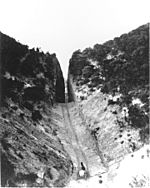
Between 1861 and 1865, the old rancho way of life was destroyed, not by the Civil War, but by nature. Heavy rains in late 1861 and early 1862 caused a huge flood. Thousands of cattle drowned, and farms were washed away. Roads were destroyed, and Los Angeles received no mail for five weeks.
After the floods, the land became lush, and cattle briefly thrived. The damaged road through San Fernando Pass was deepened and called Beale's Cut. But this relief was short-lived. Severe droughts in 1863 and 1864 followed. Cattle died or were sold for their hides. Land values dropped sharply. Locusts and a major smallpox epidemic completed the disaster. The rancho economy, built on cattle, collapsed under debt and unpaid taxes.
New Owners and Developments
Changing Hands in the Valley
After the Civil War, most of the old ranchos in the Valley were sold. In 1867, David Burbank bought Rancho Providencia and nearby land, creating a large cattle ranch. That same year, Rancho Encino was sold to James Thompson, who raised sheep, and then to the Garnier brothers. They also raised sheep but eventually lost the property due to debt.
Eulogio de Celis, who owned much of the Valley, struggled to sell his land. In 1869, after De Celis died, his vast Rancho ex-Mission San Fernando was divided. The southern half was bought by a group of investors called the San Fernando Farm Homestead Association. The main investor was Isaac Lankershim, who planned to raise sheep. His son, James Boon Lankershim, and future son-in-law, Isaac Newton Van Nuys, moved to the Valley in 1873 to manage the property.
Van Nuys believed the land could grow wheat using a method called dryland farming, which uses natural rainfall. After a drought killed most of the sheep in 1875, the land was used for wheat and barley. The Lankershim property, now called the Los Angeles Farming and Milling Company, became a huge wheat-growing business.
Railroads and New Towns
In 1874, state senator Charles Maclay and his partner, George K. Porter, bought 56,000 acres of De Celis's northern property. Most of this land was also used for wheat farming.
Maclay founded the Valley's first town, San Fernando, in 1874. It had a station for the Southern Pacific Railroad, allowing farmers to ship their wheat south. In 1876, Southern Pacific opened a tunnel through the pass at San Fernando, connecting Los Angeles by rail to San Francisco. This made train travel much faster than stagecoaches.
The world wheat market began to decline in the 1880s. When the Santa Fe Railroad reached Los Angeles in 1885, competition between the railroads brought many new settlers to Southern California. This increased pressure to divide the large Valley ranches. In 1886, David Burbank sold his ranch, and the town of Burbank was created and opened for sale in 1887.
In 1887, J. B. Lankershim and other developers bought 12,000 acres north of Cahuenga Pass. They created a townsite called Toluca (later Lankershim, now North Hollywood). They sold small farms already planted with fruit and nut trees. These trees could survive the dry summers by using the high water table from the Pacoima River.
In 1888, the community of Chatsworth Park was established in the western Valley.
The land boom of the 1880s ended by the 1890s. Despite more droughts, fruit and nut farmers managed to survive for a while. In 1895, Southern Pacific opened a new rail line to Chatsworth Park, stopping at Toluca (renamed Lankershim).
A new wagon road, the Chatsworth Grade Road, opened in 1895, bypassing the Devil's Slide. This was the first car route between the San Fernando and Simi Valleys. Rail travel to Ventura County became possible with the opening of the Santa Susana Tunnels in 1904.
Late in the 1890s, the City of Los Angeles sued all the Valley ranchers. The city claimed rights to all the water, both surface and underground, from the Los Angeles River. In 1899, the California Supreme Court agreed with the city. Without a reliable water supply, it became very hard to sell farm land in the Valley.
The 20th Century and Growth
New Century Development
In 1903, George K. Porter sold his remaining 16,200 acres in the north Valley to a group of investors. This group, the San Fernando Mission Land Company, included important Los Angeles businessmen like Henry E. Huntington and Harrison Gray Otis. One day after the city approved a plan to build an aqueduct from the Owens Valley, the company bought Porter's land.
On July 29, 1905, the City of Los Angeles announced its plan to bring water from the Owens Valley. This water would only be available to people living inside the city limits. Construction began in 1908, and water from the Los Angeles Aqueduct reached the San Fernando Valley in November 1913.
Real estate development boomed again. In the "biggest land deal ever" in Los Angeles County, a group led by Harry Chandler (from the Los Angeles Times) bought 47,500 acres of the former Mission lands. This group, the Los Angeles Suburban Homes company, planned the towns of Van Nuys, Marion (now Reseda), and Owensmouth (now Canoga Park, West Hills, and Winnetka). They also planned a system of highways and eventual annexation into Los Angeles. In November 1910, they sold off the remaining farm animals and equipment, marking "the beginning of a new empire" in Southern California.
Things changed quickly. The City of Burbank was incorporated in 1911. The Pacific Electric Railway reached Van Nuys in December 1911, Owensmouth in December 1912, and San Fernando in March 1913. In 1912, Carl Laemmle started building a movie studio on the Providencia Ranch, which became the first location of Universal City. In 1914, Universal City moved to a new, larger location, the Taylor Ranch, which is today's Universal City.
Joining Los Angeles
Valley farmers wanted to buy the extra aqueduct water, but a federal law said Los Angeles could not sell the water outside its city limits. For the Valley communities, the choice was clear: join Los Angeles or go without water. On March 29, 1915, residents of a large part of the San Fernando Valley voted to join the City of Los Angeles.
Owensmouth joined in 1917, West Lankershim in 1919, Chatsworth in 1920, and Lankershim in 1923. Even smaller, more remote parts of the Valley joined later, with most of Rancho El Escorpión joining in 1958 and the last part of Ben Porter's ranch in 1965. Burbank and San Fernando remain independent cities today.
|
Related Articles
- San Fernando Valley
- History of the San Fernando Valley to 1915
- Rancho Providencia First Movie Town 1912
- Providencia Ranch Oak Crest - Universal/Bison 101 Movies
- Nestor Studios valley ranch
- Universal City the two valley ranch locations
- Forest Lawn Memorial Park (Hollywood Hills) Movie location


